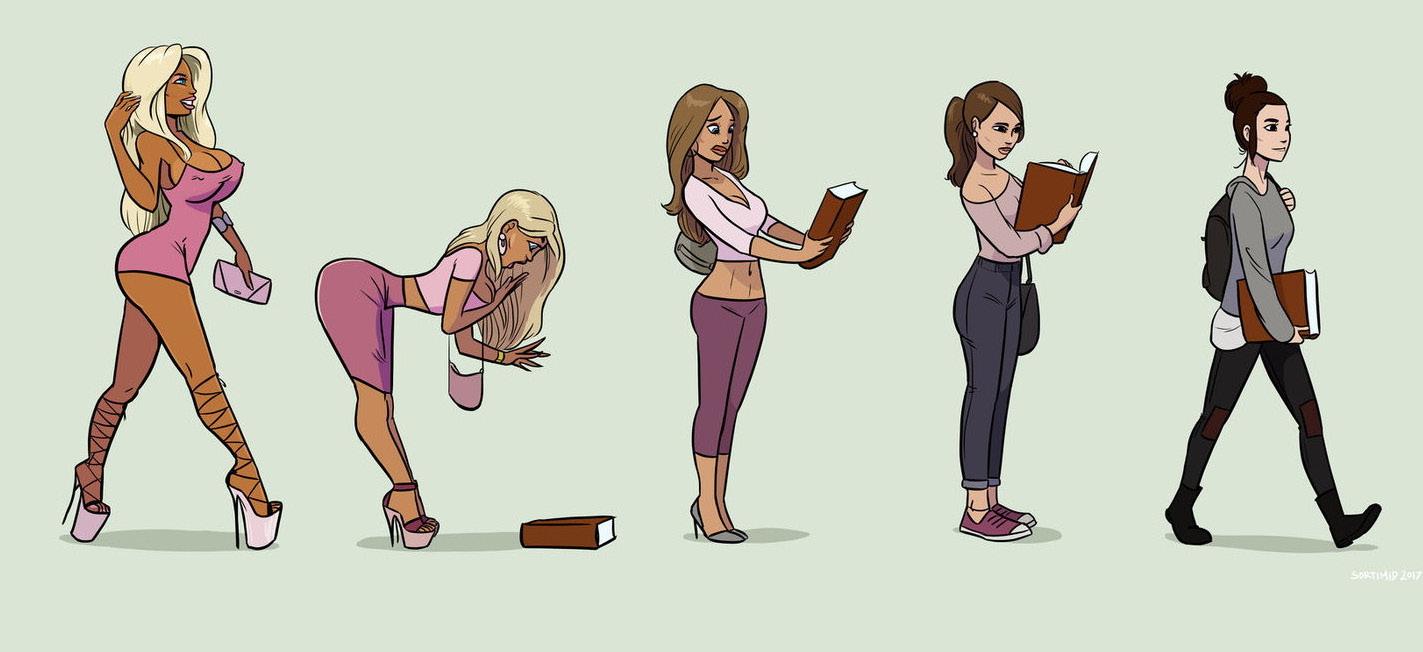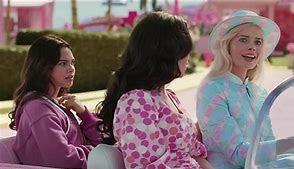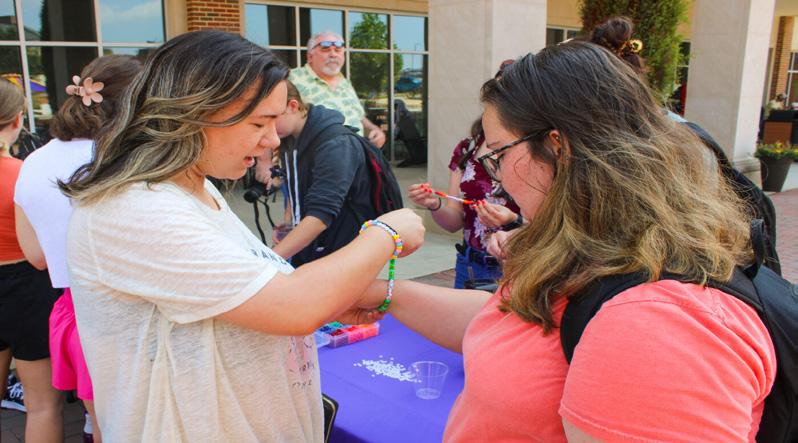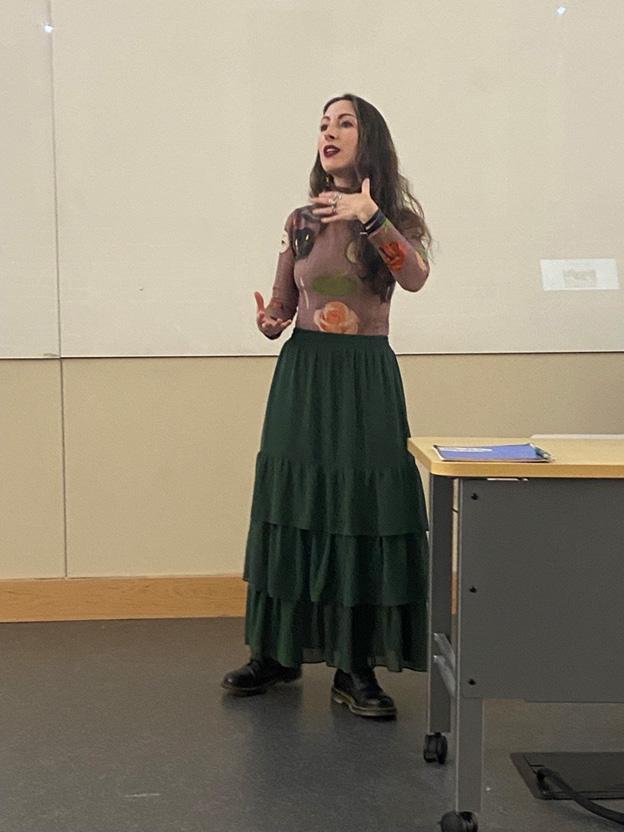Barbie Dream Gap Project
This project is a global mission dedicated to closing the gender pay gap and helping girls reach their full career potentials.
PAGE 2
Which Barbie Are You? Quiz
Take our quiz to discover which Barbie you are!
PAGE 5
Is Barbie a Feminist?
With her hyperfeminine appearance that opposes stereotypical ideas of feminism, the question remains: is Barbie a feminist?
PAGE 7
Toxic Masculinity in The Barbie Movie
The Barbie movie offers a refreshing perspective by using satire and humor to shed light on the absurdity of traditional male gender norms.
PAGE 10
Celebrating 30 Volumes of Attune
A letter from our director about Attune’s history and growth.
PAGE 11
THE WOMEN’S CENTER JOURNAL
A Letter to Barbie
Elizabeth Andrews

Hi, Barbie!
My name is Liz. We haven’t really met yet, but I wanted to officially introduce myself and tell you a little about me. Currently, I am a college student and I work two jobs. When I’m not doing either of these, you will most likely find me catching up with my family and friends. I really wanted to reach out to you and let you know that I just saw your movie not too long ago, and I LOVED IT! In probably too many ways, I related to it, but I guess that was what made me want to reach out. I know we were never that close, even though I wanted to be. My parents didn’t think you were a good influence on me which devastated me when I was younger and saddens me even more now. In some ways, I feel like I missed out on an important friendship, you know?
I like to talk to my friends about our childhoods and how my own was filled with playgrounds, hikes and baseball, and at the time, I loved it. Even now, I am sincerely grateful for the opportunities I had, but I have grown to envy my friends who had makeovers and dress up parties and dolls. It just feels like there is a whole part of my life that I have missed out on. In no way am I trying to sound ungrateful for the life I was given or the opportunities I had, but I wish I’d had the choice to do both. I so badly wanted a Barbie when I was young, but my parents didn’t want me to become “too girly” or “too materialistic.” They didn’t want a daughter who was too into her looks, her clothes or her makeup, but as I’ve gotten older, I question: Why is that bad? Why is it bad to
want to feel and look pretty? Did I have to give up playgrounds, hikes and baseball to experience girlhood? Now, at 21, the idea of Barbie represents a child-like longing and desire for an accepted expression of my own femininity.
On the other hand, I do think you would be proud of me. I’ve been trying some new things lately, things that might seem silly to most people but have been healing my inner child. I’ve started putting makeup on in the middle of the night, just to take it all off right after. I know I’m not going anywhere, but I get creative with a mean cat-eye. I don’t mind my messy room much anymore because the clothes that are sprawled out on the floor show the time I spent carefully piecing together an outfit that I feel confident in. I also like to tease my curly hair, make it as big as possible and put butterfly clips to add a pop of color. But Barbie doesn’t just stand for clothes, makeup and silly hairdos. Barbie is confidence, determination and inspiration. Barbie can be anything she puts her mind to. With representation like Doctor Barbie, President Barbie and Pilot Barbie, Barbie shows me that I can be whoever I want to be and do whatever I put my mind to. I can be smart, and I can be pretty. I can be strong, and I can be sweet. I am confident, I am determined, and I am inspired by Barbie.
I just want to say that even though I haven’t known you for very long, you have still had such an impact on me. I am late to the game at self-acceptance and feeling comfortable in my own skin, but you’ve helped me more in the past year than you will ever know. Thank you, Barbie.
Your Friend, Liz
Volume XXX, Issue 1 1 Volume XXX, Issue 1
Inside This Issue: The Tennessee Tech University Women’s Center and Commission on the Status of Women
You’re Gonna Go Far, Kid
Jessica Scarlett
The age-old question is, “What do you want to be when you grow up?” Pop star. Scientist. Musician. Pediatrician. Marine Biologist. Chef. Photographer. These are all just a handful of occupations that Mattel sells to little girls. The Barbie Dream Gap Project aims for little girls to answer that question with any occupation their hearts desire. This project is a global mission dedicated to closing the gender pay gap by challenging stereotypes and helping undo biases that hold girls back from reaching their full career potentials.
Why is it important to show young girls career opportunities in the form of a doll? Recent research from New York University suggests that gender gaps in leadership interest may start in childhood. The gap between leadership interests directly correlates with the pay gap issue women experience in adulthood. By only showing young girls the baseline career options,such as nurse, teacher or baker, they are taught to only search for those jobs. To combat this issue, Mattel has made a series of launches that encourage girls to break those stereotypes. This is important because girls need to be aware that their dreams are attainable. Whatever job they strive to have should be exposed to them at an early age. They can be nurses, chefs or writers. However, Mattel makes it known that you don’t have to stop there. Don’t shoot for nurse, you can aim for that pediatrician job. Don’t shoot for a pastry chef, you can aim to be a bakery owner. Small changes in the way toys are presented to young girls make a world of a difference, according to Mattel’s research.
can make a change. There are over 100 powerful career-driven women on Mattel’s website. To name a few: Sky Brown is a professional skateboarder, Dr. Antje Boetius is a marine researcher and microbiologist, Pat McGrath is a makeup artist and founder of Pat McGrath Labs, and Lan Yu is a fashion designer. All of these women show these young girls that it is possible to achieve any dream that they may have.
Along with creating dolls that demonstrate opportunities for young girls and giving them role models to look up to, “Barbie has donated $250,000 every year to non-profit partners that work with girls and enable them to reach their full potential” since its founda-
school girls how to study the diverse experiences of 145 girls in grades K-2” (Mattel, Dream Gap Project Section).
The gap between leadership interests directly correlates with the pay gap issue women experience in adulthood.
Another important aspect of The Barbie Dream Gap Project is to give young girls role models to look up to and to give them hope that they, too,
tion in 2019 (Mattel, Research section). Mattel has specifically chosen project partners that will benefit the self-confidence and dreams of young girls. Two of the partners they have donated to are Inspiring Girls International and Girls Leadership. Inspiring Girls International is a “non-profit dedicated to raising the aspirations of young girls around the world by connecting them with amazing female role models” (Mattel, Dream Gap Project Section). The second partnership is called Girls Leadership which “teaches girls to exercise the power of their voice through programs grounded in social-emotional learning”. Not only did the donations from Mattel help co-design “curriculum, programs and activities with girls that address racial and gender inequities”, they also “funded a research program to teach high
The Barbie movie acknowledged that dolls, no matter how amazing they are, are not enough to end the sexism that women experience in their careers and throughout their lives. But, that doesn’t mean they don’t help girls imagine a better future. As a woman, I was always taught to be in the more “feminine” and “nurturing” roles. This for me looked like being a nurse, being a teacher or being a stay-at-home mom. I was never allowed to play with Barbies because they were too “girly” in my family’s eyes. However, after researching this project, I will be putting Barbie in my child’s playroom. I want my children to obtain any job that they are interested in. If that for them is a teacher, a dental assistant or a hairdresser, then I want them to pursue that. I also want that to be true for my daughter if she wants to be a molecular biologist, a clothing designer or a doctor. Gender roles and sterotypes force women down into a smaller role, but I want my daughter to believe in her own potential. The Barbie Dream Gap Project shares that message with the world.
Attune 2
Is Barbie A Feminist?
Nicki Parish
When the Barbie movie came out this summer, I saw a post from a friend on social media that said, “Don’t waste your money on the Barbie movie, go see something else.” As I had plans to see the movie later that week, I slid up and asked why she had this opinion. She responded with, “It just had so much female empowerment and feminism and was so in your face about it that it annoyed me.... you’ll probably love it though.” To be honest, I wasn’t totally surprised that this was her opinion, but I kind of felt like she was taking a jab at me. But you know what, I did love it.

The word “feminism” has long had a stigma surrounding it. Many people write off feminists as gross, outspoken, men-hating women who think that women are better than men, which is not the case or the point for true feminists at all. Most feminists simply want men and women to stand on equal ground in all categories of life, regardless of how they express this desire or present themselves. With the release of the Barbie movie, many have begun to question if Barbie is a feminist herself and critiqued the film, as my friend did, for being too “men-hating” or having too much “female empowerment.” Some critics took this to the extreme such as Ben Shapiro, a notoriously anti-women creator, who set two Barbie dolls on fire during his YouTube video review of the film. Although it was not well-received by some watchers, Barbie’s key message mirrors that of true feminism which is that women and girls can do anything they set their mind to. With her hyperfeminine appearance that opposes stereotypical ideas of feminism, however, the question remains: is Barbie a feminist?
With her hyperfeminine appearance that opposes stereotypical ideas of feminism, however, the question remains: is Barbie a feminist?
Experts and creators have wildly differing opinions about Barbie’s feminist status. Greta Gerwig, director of the Barbie film, says that Barbie “is most certainly a feminist film,” but Ruth Handler, creator of Barbie, has never labeled Barbie as a feminist. Additionally, Mattel executives refuse to identify themselves, Barbie or the Barbie movie as feminist. While some fans are outraged by this sentiment, I think it encompasses the exact point Barbie and Ruth Handler have spent their entire careers making: women and girls can be whatever they want. Attaching the label of “feminist” to Barbie limits her ability to be anything, even if this is a label a lot of fans want her to have. M.G. Lord, the author of Forever Barbie: The Unauthorized Biography of a Real Doll, puts this concept into words beautifully, as she says, “I think that may be the secret to why she’s endured so long: That she weathers the projections and the conflicting projections of so many people.” Keeping this in mind, Barbie could be a feminist because she empowers women and girls to do whatever they set their mind to and does it while wearing pink and disproving toxic stereotypes. Or she could not be and could just be Barbie. I think that’s the entire point of Barbie; she can be whoever the fan wants her to be, and I think that’s why her creators and executives have not attached a feminist label to her.
The same ideas should apply to feminism. Feminism cannot be defined as one thing; feminism is whatever the feminist makes it. A person can be a feminist and not shave their legs and go to rallies and be the stereotypical outspoken feminist that society unfairly criticizes, but they can also wear pink and be into “girly” things and simply be a feminist by supporting women. THAT’S THE WHOLE POINT. There is no one correct way to be a feminist. There is no one correct way to be a Barbie. Ruth Handler created Barbie to show her daughter that she could be whoever she wanted to; shouldn’t the same go for feminists?


Volume XXX, Issue 1 3
Photo by Dennis Pedersen
The Struggle With Girlhood
Just as Barbie was experiencing an identity crisis, so was I.
Bailey Neal
It feels like yesterday that I was sitting on the cream-colored carpet with Barbie and all her friends. I formulated my unique version of High School Musical in which Barbie was the new girl on the way to steal Troy from Gabriella. With my two-tone pink walls as the backdrop, I acted out scenes, created crazy outfits and played for hours with my Barbie dolls until age 12. Soon after, I painted the pink walls grey and stacked all my dolls into a large tote to be stored in the attic. I suddenly longed to be 16, getting a license and wearing makeup. Discarding Barbie felt like dumping my girlhood. I had convinced myself this was the right thing to do and told myself I had to grow up. But why? Why did putting away my Barbies lead to ditching all the precious things I associated with being young and girly?
In 2013, new, more mature dolls came onto the scene. Right on cue, I started middle school, and my last year as a preteen meant ditching pinks and purples, straightening my hair, wearing mascara and trying to seem older. Every girl started going through puberty and being noticed by boys, so Barbie had to go. These newer dolls played into our preteen aspirations of glorious high school. We were looking to seem older, so a doll that is theoretically in high school is perfect. A doll that can have a locker and go on a first date? Sign me up!
Spoiler alert: middle school is the worst! My friends and I sought after being older and cooler because that meant we could be taken seriously. Barbie faced a predicament of her own. Her usual perfect blonde hair and fabulous jobs were not enough to appease the masses. “In the mid-2000s, Barbie faced her first serious competition after years of maintaining about 90% market share of the doll sector. Bratz, the edgy, bug-eyed dolls with their own smartphones and lip gloss, were ‘eating Barbie’s lunch in the older-girl demographic... ‘Barbie was having an identity crisis’” (Kenji Aoki, “Barbie Has a New Body Cover Story”). Just as Barbie was experiencing an identity crisis, so was I.
The introduction of Monster High Dolls, Bratz and even Liv Dolls gave girls that age another doll to idolize. Barbie
was no longer relatable just because she wanted her dream job. We wanted a doll with a cell phone and ripped jeans rather than a stethoscope. Since middle school, I kept the fear of someone else’s thoughts of me in the back of my head. If liking what I liked wasn’t considered cool, I would hide it. It’s a bad habit that stuck with me for a long time. I suppressed every part of my individuality to alleviate the risk of judgment. In a way, Margot Robbie’s Barbie does the same. She hides that she feels she isn’t reaching the real side of herself—the scary, dark parts and the beautiful. I wasn’t aware of how much I had done this until I saw the movie. Seeing Barbie was like returning to my two-tone pink bedroom’s soft, cream-colored carpet. I felt a piece of girly adolescence rising to the surface and snapping back into place. I walked out of the theater feeling the slight dread of womanhood yet immense freedom. My friend and I had a conversation about the expectations placed on girls. I expressed how I had repressed and tucked away my true self just as I had packed away all my dolls at the start of middle school. That reclaimed little part of the younger me has allowed me to tap into my wild creativity and love for pink. The Barbie movie helped me recapture a piece of my girlhood. An unspoken understanding that I can continue being creative and fun. I can laugh as loud as I want to, and I can express my emotions, for they don’t define my ability to work, lead or make decisions.
Attune 4

Volume XXX, Issue 1 5 Created by Aislynn Martin
“A lot of girls think they have to choose between being the smart geeky type or the beautiful bimbo.”
-Danica Mckellar
Barbie is for the Bimbos
Bethany Kelsey

Within the last few decades, we have witnessed words like queer, slut and even bitch being used to criticize people. “Bimbo” is a different phrase used to belittle and criticize. There has been a noticeable change over the past 10 years. Bimbo, once defined as “an attractive but vacuous woman,” now has a new connotation. Well-endowed blonde actresses like Marylin Monroe and Pamela Anderson, who achieved success while being treated like sex objects by men, often served as the embodiment of the stereotypical bimbo. The once-derogatory term is now being used by today’s Gen Z bimbos to empower themselves and foster a feeling of solidarity. The way women are portrayed in the media has undergone a societal shift. Famous TikTok user @maeultra, who identifies as a bimbo, says she finds it powerful to identify as such. She goes on to say, “It feels powerful and liberating to know that I’m constantly challenging gender and societal norms with hotness.” Therefore, it is now important to question any preconceived notions and question those in favor of bimbofication.
Many people picture the original Barbie when they think of the bimbo character. Although she appears to be the stereotypical bimbo at first impression, she is actually a successful leader. Barbie highlights the value of showing young girls that they can pursue any career through a variety of occupations. She champions intelligence and conventional attractiveness, which is the strategy for reclaiming and embracing bimbofication.
The goal of the movement known as “Reclaiming the Bimbo” is to empower women to assert their sexuality, embrace their femininity and reject the sexist associations that the term bimbo has historically been associated with. Millions of people identify as bimbos, and the bimbo movement—which was started by adult star and self-described bimbo Alicia
Amira—is a well-known women’s rights movement that seeks to end stigma. Sica.vee, a goth bimbo content creator, tells the magazine dedicated to women’s style Byrdie, “It’s hard to define bimbo style because it’s not one clear-cut thing. It’s about loving yourself unconditionally and embracing your femininity.” For many, bimbofication is a way of life expressed through one’s clothing rather than just a particular style or manner of presenting oneself. Sica.vee ends, “Bimbos don’t put others down for being different. We’re pro-sex work, pro-choice, pro-

Bimbo Picks Up a Book Meme by
BLM and pro-LGBTQIA+.”
According to @Fauxrich, “a bimbo is not a protest against intelligence; it’s kind of a protest against academia and how elitist and classist it is.” The bimbo of today is conscious of social issues and knows how racism, misogyny and classism affect people. Girls and women freely express their desire to defy social standards all while looking good for themselves. It is not that they are not smart; rather, it is that they are actively choosing to place emphasis in other areas that they are interested in. And like Barbie, they are making investments in things like fashion and looks that they see as being equally important to intellectual pursuits. I believe that the “character” of Barbie represents a harmony between Bimbo and being a successful leader, and that the Bimbo will continue to be reclaimed in an empowering way.
Attune 6
KnowYourMeme
Maternal ≠ Marriage and Motherhood
Lilly Davis
In the past, women would always take their husband’s last name. When we think of the women’s suffrage movement, we often think of the feminist duo, Elizabeth Cady Stanton and Susan B. Anthony. But in fact, the duo was a trio, and the third name often forgotten is Lucy Stone. The idea that women must take the man’s last name had been a cultural and societal norm since 1855, until Lucy Stone broke it. According to TIME Magazine, “Stanton once described Stone as, ‘The first woman in the nation to protest against the marriage laws at the altar, and to manifest sufficient self-respect to keep her own name, to represent her individual existence through life.’” Stone wanted to keep her last name as a sign of protest and a stand for marriage equality.
Often girls are influenced from a young age that they should look forward to marriage and finding a husband. Media also portrays this through things like Disney movies where a “princess should be swept off her feet by a prince.” There is one form of media that does not aspire to do that: Barbie. One hundred years after Stone’s accomplishment, Barbie was invented and later came Ken. Most do not know, but Barbie and Ken have full names. Barbie’s is Barbara Millicent Roberts and Ken’s is Kenneth Sean Carson. Since coming out with the Ken doll, fans have wanted Barbie and Ken to get married and have children. Notice how that has never happened. The creator of Barbie, Ruth Handler, wanted to showcase to young girls that marriage and motherhood do not have to be the ultimate ideal for women. Considering this, they instead gave her a kid sister named Skipper to signify that Barbie can
have maternal qualities without having to marry and have kids.
On a chat with National Public Radio, M. G. Lord, author of Forever Barbie: The Unauthorized Biography of a Real Doll, stated that Handler herself said to her that she would not classify herself as a feminist. But following in feminist Stone’s ideals, Handler strongly stated that Barbie would never marry because it could limit her possibilities to be whatever she wanted to be, just like Stone expressed so many years ago. On the flip side, Mattel did want to give girls who wanted a doll with a family an option.
Marriage and motherhood were never pushed on Barbie by Mattel.
They created Barbie’s best friend Midge, Margaret Hadley Sherwood, known as Happy Family Midge. She was Barbie’s traditional opposite. Mattel proceeded to create Ken’s best friend Allan, also known as Allan Sherwood. They got married and had children together, and we can hope Allan took Midge’s last name.
Though, these points were challenged when the new Barbie movie came out. Midge was first shown at the beginning of the movie with Skipper living with her and not Barbie. The narrator stated, “Midge was Barbie’s pregnant friend. Let’s not show Midge actually. She was discontinued by Mattel because a pregnant doll is just too weird.” This was before Barbie traveled to the real world and
discovered motherhood and children and understood hardships. Ultimately, we find that Barbie wants to experience real life and “not be stuck in a box”. She asked at the end of the movie if she could become human and Ruth tells her she cannot control her from what she wants to achieve. She compared Barbie to her own daughter stating, “We mothers stand still so our daughters can look back to see how far they’ve come.” A collage of short clips of childhood and motherhood, love and grief, adventure and excitement and old and young is then shown. Though we do not know if Barbie goes on to start a family of her own in the real world, we do know that she became a role model to Sasha, the teenage girl, in the Barbie movie.
Marriage and motherhood were never pushed on Barbie by Mattel. Barbie today is a strong feminist icon for girls everywhere expressing they can be whoever they want to be. This is just how Stone wanted to be. She did not want to take a man’s last name and lose the mark she had already left on the world. Just as Lucy Stone challenged societal norms by keeping her maiden name upon marriage, Mattel’s portrayal of Barbie sends a powerful message that women can maintain their individuality and independence. This choice reflects the ongoing evolution of gender roles and reinforces the idea that women, trailblazers like Lucy Stone, can pave their own future, identity and destiny, unburdened by traditional expectations of marriage. In this context, Barbie becomes not just a toy but a symbol of empowerment for generations of girls and women everywhere.


Volume XXX, Issue 1 7
Gifting Life to Us Again
Mother-Daughter Relationships in Barbie
Anna Gatlin
There are several different themes in Barbie that highlight social issues such as misogyny, toxic masculinity and consequences of a patriarchal society. Each of them serves a purpose in their own way and reaches their target audience in the process. However, there is one aspect that drives the story forward and encapsulates the heart of the film: mother-daughter relationships. Daughters have an innate need to be known and understood through their mother’s eyes, and, in the case of Barbie, that allows them to become their own person.
The first glimpse of a mother-daughter relationship is with the characters Sasha, a hardened teen, and Gloria, Sasha’s seemingly perfect, hardworking mother. We quickly learn of Sasha’s reluctance to trust or admire Barbie despite Barbie’s claims of being perfect and empowering for young women. This stems from Sasha’s strained relationship with Gloria, particularly because of Gloria’s seemingly “perfect” appearance to the public. A mother in the spotlight puts an impossible amount of pressure on her daughter to be held in the same light, otherwise the daughter could be pressured, either by society or the mother, to become an unrealistic and unhealthy version of herself. Instead of succumbing to that, Sasha has taken the approach of becoming the very opposite of Gloria.
A sense of understanding between a mother and daughter cannot be overstated, but it must go both ways...
not her daughter, is the one playing with Barbie. Then Sasha realizes her mother isn’t as perfect as she once believed, given Gloria’s drawings of “cellulite Barbie” and “contemplating death” Barbie. Sasha comes to the conclusion that her mother is more like her than she originally thought, and that opens the door for meaningful conversation between the two. A sense of understanding between a mother and daughter cannot be overstated, but it must go both ways for progress to be made. This is shown through Gloria’s monologue about the misgivings and hardships of womanhood, something both herself and Sasha can relate to despite their difference in age and place in society. Gloria reaches Sasha by showing her that they have something they both can find unity through, and Sasha reaches Gloria by validating her stance on women’s issues and her position as a mother.

tunity to guide Barbie through the uncertainties of the new world around her, effectively setting her free. Barbie found Ruth in the most unpredictable of times, and she found a peace unlike anything she’d ever known. Although Ruth had been absent from Barbie’s life, she knew what she needed to do for Barbie’s sake. A mother may not always be there to help their daughter discover themselves, but they can give life to them, again, by allowing them to grow on their own.
Gloria and Sasha’s relationship begins its mend once they discover that Gloria,
For every mother-daughter relationship that mends from both perspectives, there are some that find solace through one-way reassurance. Sometimes a mother can be self-aware of what environment she has created for her daughter and still leave her to her own devices. However, in the case of Ruth Handler— as shown in Barbie—she takes an oppor-
On the surface, the struggles of womanhood shine throughout Barbie in ways that highlight individual growth. When taking a deeper dive, collaboration and unity between women is amplified in the case of overcoming misogynistic prejudices. Not only are these collaborations shown amongst women of similar age but between women in different steps of life, specifically between mothers and daughters. It can also be said that a daughter’s autonomy is separate from that of their mother’s, and it’s incredibly important that mothers allow them to find that self-sufficiency. We can take these examples from Barbie and compare them to our own lives. Whether we can find something that speaks to our daughterhood, motherhood or womanhood is up to both our individual and collective experiences as a woman.
Attune 8
Photo from Barbie by Warner Bros Pictures
Bye, Barbie
A short story by
Stacy Parish
She stood at the top of the staircase leading into the once spacious and now cavernous room that had served her family so well over the past 16 years. The early afternoon sunlight slanted starkly into the room, as the heavy damask curtains had been removed and the blinds were rolled completely to the top of the frame. Every scuff on the walls and every stain on the carpet was thrown into stark contrast, yet to her eyes was merely evidence of a space that had once been warm and inviting. It was now devoid of everything except what remained in the large closet that had once housed board games, toys, craft supplies and an army of Barbies and their myriad outfits and accouterments.
It had, in turns, been a playroom for her children when they were young; a cozy den for family time at home, spent watching silly television shows and movies and football games; a hangout area for her teenagers and their friends; and now was just an almost-empty room in a house that would soon belong to someone else.
She set her Barbie-pink insulated mug down on the windowsill and sat cross-legged on the floor to begin assembling the moving boxes she brought with her to complete this task. This task that she had admittedly put off until the end of this painful but necessary process. From this vantage point, she had a closer view of the dozen or so indentations in the carpet where the sectional sofa had been. It seemed like yesterday that her daughters were napping on that couch as toddlers, or sprawled across it when they were tweens and teens, but yesterday that sofa found a new home in a fraternity house.
As she unfurled her legs from the crisscross-applesauce position she had (uncomfortably) been sitting in and braced her hand on the carpet to propel herself upright, she felt something small but firm underneath her palm, like a tiny bean. She pinched it between two fingernails, hoping that it was not something gross, and laughed aloud when she realized what it was. Tanner poop. Years ago, a friend who had four sons and never missed an opportunity to buy “girly toys” gave her daughters a Barbie who had a little golden retriever named Tanner that expelled these little brown pellets from his posterior. This gift resulted in hysterical laughter from her girls back then, and the memory of it brought tears to her eyes now.
This feels like a good time to take a break, she thought to herself, and immediately that line from Barbie in “Toy Story” that she and her girls used to say to each other popped into her head (“I can’t keep smiling like this anymore. I am exhausted. I think I need a break. A little break? Okay.”) She absentmindedly put the poop pellet in her pocket and walked to the window to retrieve her tumbler. The glass was warm on her back from the low autumn sun as she leaned against it, perched on the sill. She reflected on how such a small physical space could hold so many large memories. She allowed herself a few more sips of Lady Grey tea that had cooled to lukewarm during her playroom reverie, before opening the closet door that would lead to the closing of a chapter of her life.
Volume XXX, Issue 1 9
Toxic Masculinity in Barbie
Rachel Flowers
With the release of the Barbie movie, the themes like feminism, toxic masculinity and patriarchy that the film touches on have been major talking points for discussion. Despite Barbie discussing these themes in a comical way, it was still able to create an opening for us to address the ways that toxic masculinity presents itself in society. Toxic masculinity is a concept used to describe the negative facets associated with traditional male gender roles. It encompasses behaviors such as the pursuit of dominance, the devaluation of women, homophobia and the propensity for violence. This phenomenon not only stigmatizes and constrains the range of emotions that boys and men feel comfortable expressing, but also fosters an environment that hinders progress in society. The Barbie movie offers a refreshing perspective by using satire and humor to shed light on the absurdity of traditional male gender norms. Instead of reinforcing toxic masculinity, the film takes a different approach, cleverly mocking and challenging these harmful stereotypes.

One way the Barbie movie addresses toxic masculinity is through its satirical portrayal of traditional gender roles. Toxic masculinity dictates that men should be strong, dominant and emotionally reserved, leading to the perpetuation of harmful stereotypes. In the film, male characters are depicted in an exaggerated manner, highlighting the ridiculousness of these traditional norms. For example, Ken is characterized by his muscular physique and chiseled jaw, but his role in the beginning of the film is to exist for Barbie’s validation. By amplifying the traits associated with toxic masculinity, the movie highlights how these expectations can be unrealistic and detrimental. Furthermore, the Barbie movie pokes fun at the emphasis on physical strength and dominance associated with toxic masculinity. During the movie when Barbie Land gets turned into Ken Land, you can see the Kens sitting around lifting weights and doing bicep curls to mock the traditional male stereotype that men should be big and buff. Furthermore, while it does not explicitly endorse violence, the film showcases the folly of valuing physical prowess above all else. Through comical scenarios and exaggerated portrayals of male characters, like John Cena showing up as a mermaid, the movie highlights the senselessness of placing such importance on physical strength as a measure of masculinity.
The film also employs humor to make fun of toxic masculinity by deconstructing its elements. Instead of devaluing female characters, the Barbie movie subverts expectations. Female characters are often portrayed as intelligent, resourceful and self-reliant, challenging the stereotype that women are passive or subordinate. This reversal not only provides comedic relief but also delivers a powerful message about gender equality and the capacity of women to excel in various roles. In his own analysis of the Barbie movie called How the Barbie Movie is Making Toxic Masculinity Uncomfortable, Nathan Chen wrote, “It goes on to show Barbie having an existential crisis, daring to question her identity, and stepping out of her pink utopia to seek answers. Now, that’s not the damsel-in-distress narrative we’ve grown accustomed to, is it?” Additionally, the movie manages to touch on LGBTQ+ matters without being forthright. The movie’s cast features many actors in the LGBTQ+ community, one of which is an openly transgender woman named Hari Nef, who plays one of the Barbies. While toxic masculinity often promotes prejudice against non-heteronormative sexual orientations, the Barbie movie takes a different path. It uses satire to challenge the notion that anything non-conforming to traditional masculinity should be ridiculed or feared. By presenting diverse characters and relationships in a light-hearted manner, the film encourages acceptance and celebrates individuality.
The Barbie movie takes a commendable approach to challenging toxic masculinity through satire and humor. Instead of reinforcing harmful stereotypes, the film uses exaggeration and clever storytelling to mock traditional male gender norms. By shedding light on the absurdity of toxic masculinity, the movie encourages viewers, especially children, to question and rethink these harmful stereotypes. The film not only entertains but also offers valuable lessons about gender equality, acceptance and the importance of embracing a diverse and inclusive world.
Attune 10
Photo from Barbie by Warner Bros Pictures
Celebrating 30 Volumes
Letter from WMC Director Helen Hunt

This year is Attune’s 30th anniversary, and I could not be more proud of what this publication has accomplished over three decades. Since this is the fall issue, we are finishing it around the winter holidays. These celebrations often center around family traditions, honoring those who have come before us. We remember the past and the people who created our holiday magic by cooking their recipes, hanging the stockings they embroidered with our names, singing the songs they taught us and celebrating with gratitude the families we’ve built—chosen families and kinship ones—through their love and legacies. So it is fitting for me to take a moment of gratitude and thank the people—most of whom are women—who founded our Women’s Center, started Attune, and performed the loving labor of writing, editing, producing and archiving its pages for 30 years.
Thank you, each and every one of you. Because of you, we
have this incredible record of the thoughts, concerns, voices and visions of women’s issues at Tennessee Tech through the decades. And we also have a beautiful venue for students and the wider community today to make their perspectives known. And to create a product worthy of pride, that students themselves have designed, edited and produced. I especially enjoy our turn toward the creative in the last few issues; it has been a pleasure to showcase visual art and creative writing—to teach and delight. I hope to live up to the legacy of these contributions and continue to act as a good steward of the rich material Attune has to offer for our readers.
Sincerely,
Helen Hunt
WMC Events of the Semester Photo Gallery
From our affirmation bracelet-making event (left), sexual wellness workshops (top middle), gallery opening (bottom middle) and Pam Grossman’s talk entitled, Witch Pictures: Female Magic and Transgression in Western Art (right).





Volume XXX, Issue 1 11
Editors
Nicki Parish, Editor
Women’s Center Staff
Helen Hunt, Ph.D., Director
Jordan Dicey, Admin Associate
Elizabeth Andrews
Lilly Davis
Rachel Flowers
Anna Gatlin
Bethany Kelsey
Aislynn Martin
Bailey Neal
Jessica Scarlett
Contact Us
womenscenter@tntech.edu
Facebook TnTech Women’s Center
Instagram @tntechwomenscenter
Office Hours
RUC 339
Monday - Friday 8 a.m. - noon & 1 p.m. - 4:30 p.m.
Visit our website tntech.edu/women

Tennessee Tech University
Women’s Center
Roaden University Center (RUC) 339 1000 North Dixie Ave. Cookeville, TN 38505
Get Help
Health Resources
Counseling Center
931-372-3331 tntech.edu/counsel
Eagle Eye Crisis Hotline 855-206-8997*
Health Services 931-372-3320
tntech.edu/healthservices
Food Pantry tntech.edu/volunteer/pantry.php
Tech ASPIRES
931-372-6566 or Eagle Eye Hotline
University Resources
Title IX tntech.edu/titleix titleix@tntech.edu
Campus Police
931-372-3234
tntech.edu/police
Educational Resources
Women’s Center tntech.edu/women
Multicultural Affairs tntech.edu/multicultural-affairs
Community Resources
Genesis House
Office: 931-525-1637
Hotline: 1-800-707-5197* genesishouseinc.com
Upper Cumberland Family Justice Center 931-528-1512 or 866-704-1080 ucfamilyjusticecenter.org
Cookeville Legal Aid Society 931-528-7436 las.org
National Resources
National Suicide Prevention Lifeline 800-273-8255*
National Sexual Assault Hotline 800-656-4673*
National Domestic Violence Hotline 800-799-7233* thehotline.org
VictimConnect Resource Center 855-484-2846
Attune 12
We can help you navigate resources! Call the Women’s Center: 931-372-3850 Message us on social media: @tntechwomenscenter
*resources available 24/7 AAR359-PRNT-24
















